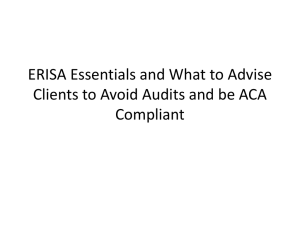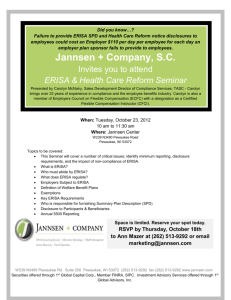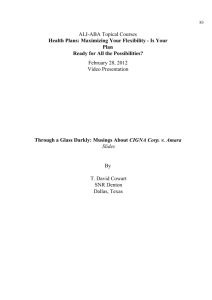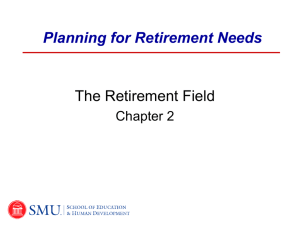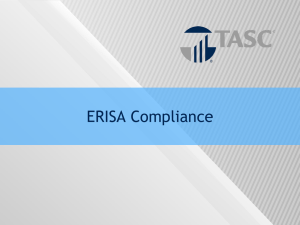Audits....ugh
advertisement
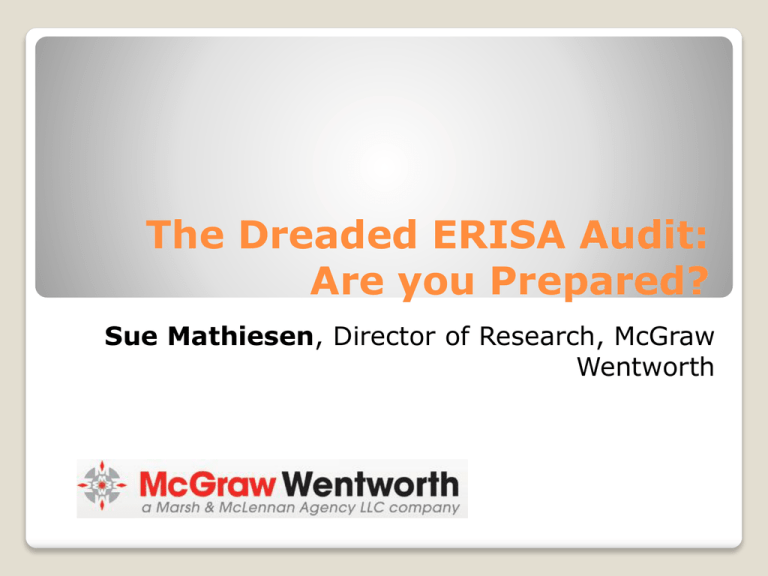
The Dreaded ERISA Audit: Are you Prepared? Sue Mathiesen, Director of Research, McGraw Wentworth Audit Activity is Ramping Up DOL actively auditing employer plans and letters getting worse 2010 – audits, what audits? 2013 letters asking for more than 2012 letters (HIPAA added) Typical audit letter includes 6 pages of requested materials with several years of documents requested Typically 30 to 45 days to produce requested documents Have seen documents requested in as little as 10 DAYS Employers can request an extension of time – request this extension if you need extra time Be sure to organize the information requested – auditors appreciate an organized submission 2 How Can You Survive An Audit? You will survive an audit if prepare for the items they request Focus on the scope of items requested Today we will review the elements in the typical audit letter Review and explain the requirement Provide you with DOL resources, model language and recommendations You may have a number of areas that you need to address You will not be able to fix everything overnight-schedule time each week to tackle areas that you need to address 3 1. ERISA Plan Document The plan administrator must furnish copies of certain documents upon written request and must have copies available for examination Plan document establishes an employer’s ERISA plan Must indicate the 500 series plan number Must specify the plan name – “Health and Welfare plan of ABC Company” Can consist of more than one benefit (health, dental, life, etc) This document is very similar to the SPD or is a document that will refer to each SPD for every benefit covered by the plan More information on ERISA can be found at: http://www.dol.gov/ebsa/compliance_assistance.html 4 2. ERISA Summary Plan Description Primary vehicle for informing participants and beneficiaries about their plan and how it operates – many rules Must be written for average participant and apprise covered persons of their benefits, rights, and obligations under the plan Must accurately reflect the plan’s contents as of the date not earlier than 120 days prior to the date the SPD is disclosed Summary of required content: Cost-sharing provisions, including premiums, deductibles, coinsurance and copayment amounts Annual or lifetime caps or other limits on benefits under the plan The extent to which preventive services are covered under the plan Whether, and under what circumstances, existing and new drugs are covered under the plan Statement of ERISA rights under the plan Conditions or limits applicable to obtaining emergency medical care 5 2. ERISA Summary Plan Description Required SPD content (continued): Whether, and under what circumstances, coverage is provided for medical tests, devices and procedures Provisions governing the use of network providers and under what circumstances, coverage is provided for out-of-network services Conditions or limits on the selection of primary care providers or providers of specialty medical care Provisions requiring preauthorizations or utilization review How plan benefits may be obtained and the process for appealing denied benefits Distribution rules To participants within 90 days of becoming covered by the plan Updated SPD must be furnished every 5 years if changes made to SPD information or plan is amended If no changes made, must be furnished every 10 years 6 3. Form 5500s Typically request the last 3 years of 5500s Not all plans have to file 5500s Exemption for small unfunded, insured, and combination unfunded/insured welfare plans “Small” for these purposes is defined as fewer than 100 participants at the beginning of the plan year Unfunded – no plan assets (this could be an issue if a plan uses a trust account or separate account to fund benefits) More details on 5500s http://www.dol.gov/ebsa/5500main.html Troubleshooting guide to filing 5500s http://www.dol.gov/ebsa/pdf/troubleshootersguide.pdf 7 4. All Insurance Contracts For insured plans, this would include all insurance contracts governing benefits and detailing employer rules Remember, many employers have a number of different benefits covered under one ERISA plan For example, ABC’s Health and Welfare Plan 501 covers life, medical, disability, and dental benefits All the insurance contracts associated with these benefits must be provided 8 5. All Contracts – Self-funded Plans Most employers that self-fund any of their benefits hire service providers for specific plan services Administrative services contract for eligibility and claims payment Reinsurance contracts (both specific and aggregate) PPO network contracts (if direct relationships) Contracts with any vendors that provide Independent Reviews for appeals under the self-funded medical plan Please note, if a plan is self-funded that must be disclosed in the ERISA plan document and SPD 9 6. Cost Sharing Provisions Many of the benefits offered under an ERISA plan are contributory ERISA requires employer plan documents to outline the cost sharing splits between employee/employer Applies to premium (if split is percentage, share percentage) For any other type of contribution arrangement, the funding split needs to be disclosed-this can be done in an addendum to the SPD Cost-sharing related to services covered by the plan must also be disclosed (typically included in SPD) 10 7. A Number of HIPAA Disclosures A copy of eligibility and enrollment rules for the plan Certificates of creditable coverage (requirement expires 12/31/2014) Sample certificate of creditable coverage Record of certificates of creditable coverage provided Copy of written procedures to request/receive certificates of creditable coverage Pre-existing condition requirements (only applies if plan has pre-existing condition limitation-can’t have pre-ex after 2014) General notice of pre-existing condition limitation Copies of individual notices relating to pre-ex limitation Criteria to demonstrate creditable coverage by an alternative means Records of claims denied due to a pre-existing condition 11 7. A Number of HIPAA Disclosures Copy of written procedures that provide special enrollment rights under the plan Information regarding benefit claim determinations Adverse benefit determinations must include required disclosures The specific reason(s) for the denial of a claim • Reference to the specific plan provisions on which the benefit determination is based • A description of the plan’s appeal procedures • A copy of the written appeal procedures established by the plan 12 8. Mental Health Parity Provisions Copy of the plan provisions related to benefits for medical/surgical services and mental health/substance abuse Mental Health Parity and Addiction Equity Act applies to most employers Small group (under 50 lives) self-funded exemption Cost increase exemption (but must comply every other year) Requires parity between medical/surgical services and mental health/substance abuse services Cost-sharing elements Non-quantitative rules (pre-certification, requirement to use outpatient facilities, and so on More information at http://www.dol.gov/ebsa/mentalhealthparity/ 13 9. Newborns’ Mothers’ Protection Act Plan language on the Newborns’ and Mothers’ Health Protection Act (NMPA) Group health plans and health insurance issuers generally may not, under federal law, restrict benefits for any hospital length of stay in connection with childbirth for the mother or newborn child to less than 48 hours following a vaginal delivery, or less than 96 hours following a cesarean section. However, federal law generally does not prohibit the mother's or newborn's attending provider, after consulting with the mother, from discharging the mother or her newborn earlier than 48 hours (or 96 hours as applicable). In any case, plans and issuers may not, under federal law, require that a provider obtain authorization from the plan or the issuer for prescribing a length of stay not in excess of 48 hours (or 96 hours). Must be included in SPD 14 10. Prior Authorization Rules Copy of SPD language and rules for pre-authorization requirements Specific to hospital stay in connection with childbirth (meets NMPA requirements) Specific to mental health and substance abuse treatment (make sure it is parity with medical/surgical requirements) 15 11. WHCRA Information Written description of benefits mandated by the Women's Health and Cancer Rights Act (WHCRA) that is provided upon enrollment Can be included with enrollment materials or in SPD (but only if SPD is distributed at enrollment) Notice must include key elements required by WHCRA • • • If a plan provides coverage for mastectomies, it must also provide coverage for reconstructive surgery Coverage must be provided for surgery and reconstruction on the other breast to provide a symmetrical appearance Coverage must be provided for prostheses Elaws resources (included model notice language) http://www.dol.gov/elaws/ebsa/health/employer/NewMenu.asp 16 12. WHCRA Information Language provided as required by WHCRA to participants on an annual basis Should be included with open enrollment materials-more of a summary Do you know that your plan, as required by the Women’s Health and Cancer Rights Act of 1998, provides benefits for mastectomy-related services, including all stages of reconstruction and surgery to achieve symmetry between the breasts, prostheses, and complications resulting from a mastectomy, including lymphedema? Call your plan administrator at [insert phone number] for more information. 17 13. Wellness Plans Information Wellness and disease management program descriptions The plan language must address any rewards provided by these programs Reward programs must contain all the details How rewards are earned Amount of any potential rewards (make sure in line with HIPAA nondiscrimination requirements) Health contingent wellness plans • • • When individuals can qualify for the rewards (must be allowed annually) If criteria for reward is based on the achievement of a health factor, an alternative standard must be offered Depending on the type of wellness plan • Alternative must be provided only if medically necessary (activity-only wellness plans) • Alternative must be provided to everyone in an outcomes-based wellness plan 18 14. COBRA Notices All Notices General Notice (initial notice) COBRA Election Notice Notice of Unavailability of COBRA Notice of Insufficient Payment Notice of Early Termination of COBRA Helpful COBRA Guide for Employers http://www.dol.gov/ebsa/publications/cobraemployer.html Model notices http://www.dol.gov/ebsa/compliance_assistance.html#section2 19 15. Grandfathered Plan Disclosure of grandfathered status statement required for any plan documents (newsletters and SPDs) This [group health plan or health insurance issuer] believes this [plan or coverage] is a “grandfathered health plan” under the Patient Protection and Affordable Care Act (the Affordable Care Act). As permitted by the Affordable Care Act, a grandfathered health plan can preserve certain basic health coverage that was already in effect when that law was enacted. Being a grandfathered health plan means that your [plan or policy] may not include certain consumer protections of the Affordable Care Act that apply to other plans, for example, the requirement for the provision of preventive health services without any cost sharing. However, grandfathered health plans must comply with certain other consumer protections in the Affordable Care Act, for example, the elimination of lifetime limits on benefits. Questions regarding which protections apply and which protections do not apply to a grandfathered health plan and what might cause a plan to change from grandfathered health plan status can be directed to the plan administrator at [insert contact information]. [For ERISA plans, insert: You may also contact the Employee Benefits Security Administration, U.S. Department of Labor at 1-866-444-3272 or www.dol.gov/ebsa/healthreform. This website has a table summarizing which protections do and do not apply to grandfathered health plans.] [For individual market policies and nonfederal governmental plans, insert: You may also contact the U.S. Department of Health and Human Services at www.healthreform.gov.] Records documenting terms of the plan as of March 21, 2010 and must demonstrate plan maintenance of grandfathered status 20 16. Notices for Health Reform Written notice of dependents enrollment opportunity when plan extended coverage to age 26 Individuals whose coverage ended, or who were denied coverage (or were not eligible for coverage), because the availability of dependent coverage of children ended before attainment of age 26 are eligible to enroll in [Insert name of group health plan or health insurance coverage]. Individuals may request enrollment for such children for 30 days from the date of notice. Enrollment will be effective retroactively to [insert date that is the first day of the first plan year beginning on or after September 23, 2010.] For more information contact the [insert plan administrator or issuer] at [insert contact information]. Copies of coverage rescissions showing 30 day advance notice Show annual and lifetime dollar limits for the plan (9/23/2010) Show notice of lifetime dollar limit no longer applying The lifetime limit on the dollar value of benefits under [Insert name of group health plan or health insurance issuer] no longer applies. Individuals whose coverage ended by reason of reaching a lifetime limit under the plan are eligible to enroll in the plan. Individuals have 30 days from the date of this notice to request enrollment. For more information contact the [insert plan administrator or issuer] at [insert contact information]. 21 17. Medical Loss Rebates All documents related to the receipt and disposition of any medical loss rebates paid by an insurance carrier ERISA plans need to be cautious with Medical Loss Ratio rebates Rebates tied to employee contributions to the plan will likely be considered plan assets ERISA requires that plan assets be held in trust until the point when they are needed to fund eligible claims or administrative expenses Trust non-enforcement stance will apply to premium rebates if they are used within three months of receipt. The employer can use them to pay premiums or to issue rebates to plan participants. Fiduciaries must act prudently and solely in the interest of plan members, rebates tied to employee contributions should be used to offset employee contributions or be provided as a rebate 22 19. Non-Grandfathered Plans Notice of rights to designate any participating primary care physician – model language [Name of group health plan or health insurance issuer] generally [requires/allows] the designation of a primary care provider. You have the right to designate any primary care provider who participates in our network and who is available to accept you or your family members. [If the plan or health insurance coverage designates a primary care provider automatically, insert: Until you make this designation, [name of group health plan or health insurance issuer] designates one for you.] For information on how to select a primary care provider, and for a list of the participating primary care providers, contact the [plan administrator or issuer] at [insert contact information]. For plans and issuers that require or allow for the designation of a primary care provider for a child, add: For children, you may designate a pediatrician as the primary care provider. For plans and issuers that provide coverage for obstetric or gynecological care and require the designation by a participant or beneficiary of a primary care provider, add: You do not need prior authorization from [name of group health plan or issuer] or from any other person (including a primary care provider) in order to obtain access to obstetrical or gynecological care from a health care professional in our network who specializes in obstetrics or gynecology. The health care professional, however, may be required to comply with certain procedures, including obtaining prior authorization for certain services, following a pre-approved treatment plan, or procedures for making referrals. For a list of participating health care professionals who specialize in obstetrics or gynecology, contact the [plan administrator or issuer] at [insert contact information]. 23 19. Non-Grandfathered Plans Copies of documents relating to the coverage of preventive care services as of the first day of the first plan year on or after 9/23/2010 Remember coverage requirements can change (expansion of well woman services) New requirement to cover preventive breast cancer medications for high risk women Copy of the plan’s internal claim appeals and external review processes Copy of a notice of initial and final adverse benefit determinations and notice of final external review decision If applicable, any contract with independent review organization or TPA providing external review 24 21. Genetic Information All documents related to use or collection of genetic information for any reason with respect to the plan GINA information must be included in EEOC poster Any request for medical information Request for genetic information for toxic substance monitoring Notice of disclosure EEOC poster – model can be found at http://www.dol.gov/ofccp/regs/compliance/posters/pdf/eeop ost.pdf GINA FAQs http://www.dol.gov/ebsa/pdf/faq-GINA.pdf 25 New Information May Be Added Summary of Benefits and Coverage (SBCs) Marketplace Notices HIPAA Special Enrollment Rights, CHIP and Medicaid notices Medicare Part D Notices of Creditable Coverage More HIPAA – Privacy Requirements (may be separate audit) Notice of HIPAA Privacy Practices Notice of breaches of unsecured protected health information Policies and procedures related to Privacy and Security compliance Qualified Medical Child Support Order Notices FMLA Notices and Policies USERRA Notice (poster) 26 Potential Penalties ERISA includes both civil and criminal penalties Potential ERISA Civil Violations Failing to operate plan prudently & for the exclusive benefit of participants Using plan assets to benefit certain related parties to the plan Failing to follow the terms of the plan (unless inconsistent with ERISA); Taking any adverse action against an individual for exercising his or her rights under the plan Failure to comply with ERISA Part 7 and the Affordable Care Act (welfare plans only) ERISA Criminal Provisions EBSA also conducts investigations of criminal violations regarding employee benefit plans such as embezzlement, kickbacks, and false statements under Title 18 of the U.S. Criminal Code 27 More Resources More details on DOL ERISA enforcement http://www.dol.gov/ebsa/erisa_enforcement.html More details on requirements for health plans http://www.dol.gov/ebsa/publications/CAG.html 28 Summary Insights Is that all? Most employers will have at least one aspect that will be audited that they should address more thoroughly It also makes sense to document the process that is used to distribute all required publications and notices If you are audited-don’t panic Gather and submit the materials requested Good faith compliance efforts are recognized - most audits result in the DOL making recommendations to improve materials Rarely are penalties assessed unless you don’t cooperate or have not made efforts to comply 29 Any Questions? CLICK HERE TO EDIT TEXT 30
